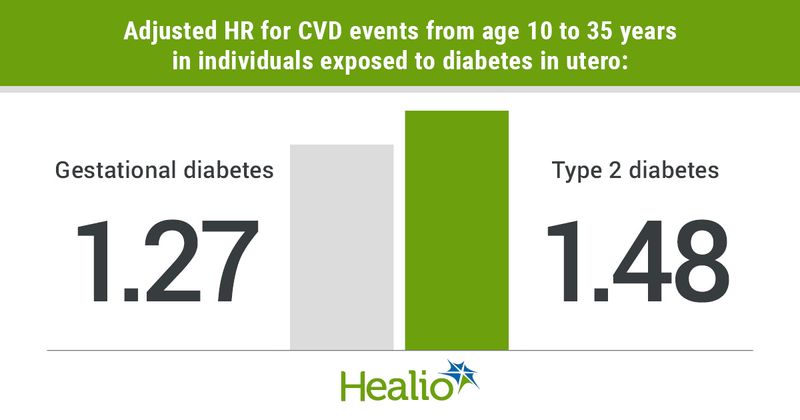Diabetes in pregnancy leads to elevated risk for CVD in offspring
Exposure to diabetes in utero was associated with an elevated risk for CVD events and risk factors in offspring from the ages of 10 to 35 years, according to research published in CMAJ.
“Cardiovascular disease is often considered an adult disease predominantly linked to poor lifestyle habits,” Laetitia Guillemette, PhD, a scientific reviewer at Health Canada’s Bureau of Cardiology, Allergy and Neurological Sciences, told Healio Primary Care. “This study shows that early-life exposures such as exposure to diabetes in utero can also increase cardiovascular disease risk in people without long-term exposure to these lifestyle habits.”

Guillemette and colleagues conducted a cohort study of individuals born in Manitoba, Canada, from April 1979 through March 2005, using administrative data from the Manitoba Population Research Data Repository. Those included in the study were followed through March 2015, with the longest follow-up period being 35 years among participants.
Researchers identified first incident of a CVD endpoint, including cardiac arrest, myocardial infarction, ischemic heart disease and cerebral infarction that was not viral, familial or alcoholic in origin, and first incident of a CVD risk factor, including hypertension, dyslipidemia and type 2 diabetes, that occurred in offspring from the age of 10 years and throughout follow-up.
The age of 10 years was chosen because it was previously used by researchers to distinguish inherited and acquired CVD-related risk factors.
Researchers also identified the first incident of a CVD risk factor among participants, including a diagnosis of hypertension, dyslipidemia and type 2 diabetes.
Overall, 293,546 offspring of 189,939 mothers were included in the study. Of those, 96.1% were not exposed to maternal diabetes, 2.8% were exposed to gestational diabetes and 1.1% were exposed to pre-existing type 2 diabetes.
During the average 20.5-year follow-up period, 5.3% of offspring experienced a risk factor or event related to CVD — 0.9% experienced a CVD end point, and 4.3% experienced a CVD risk factor.
After adjusting for maternal age, socioeconomic factors, preterm birth and other factors, researchers determined that the risk for CVD events was elevated among those exposed to gestational diabetes in utero (adjusted HR [aHR] = 1.27; 95% CI, 1.02–1.59) and type 2 diabetes (aHR = 1.48; 95% CI, 1.05–2.07).
Researchers observed a similar elevated risk for CVD risk factors in those exposed to gestational diabetes (aHR = 1.85; 95% CI, 1.69–2.02) and type 2 diabetes (aHR = 3.38; 95% CI, 3.02–3.77).
According to researchers, the elevated risks were primarily driven by higher rates of hypertension, type 2 diabetes and ischemic heart disease among people with intrauterine exposure to diabetes.
Researchers also found that the first CVD-related outcome occurred 2 to 4 years earlier in those exposed to gestational or type 2 diabetes in utero than in those who were not.
“Diabetes is now one of the most common metabolic conditions of pregnancy; following the study's conclusions, it is making exposed children and young adults at increased cardiovascular risk, thereby not only increasing the number of cardiovascular patients in our communities but also likely leading to a younger age at diagnosis,” Guillemette said. “This has the potential to significantly impact the primary care burden, since more patients will need to be treated and followed for a longer period of time, unless we find ways to intervene at a broad scale.”

